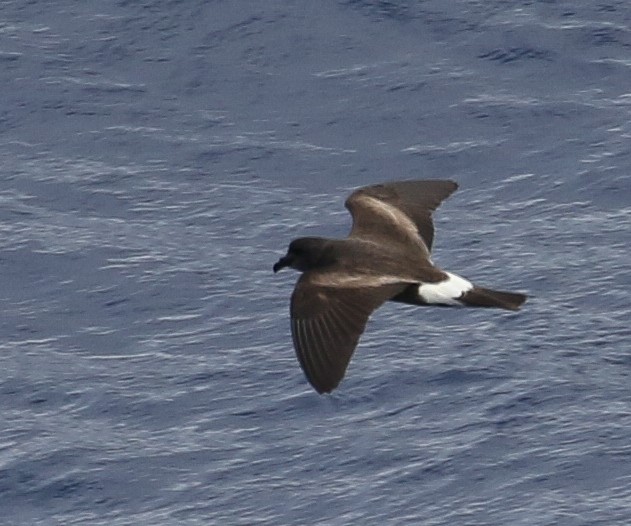Birdfinding.info ⇒ The mid-oceanic South Atlantic form of Band-rumped Storm-Petrel is locally common in the waters around the remote islands where it breeds. It is not known to occur elsewhere. Unlike most other storm-petrels, it attends the nest during the day.
“St. Helena Storm-Petrel”
Hydrobates castro helena
Breeds at Ascension and St. Helena; disperses into the tropical South Atlantic.
Nests in colonies on islets adjacent to two remote tropical islands in the middle of the South Atlantic: Boatswain Bird Island beside Ascension Island, and Speery and Egg Islands beside St. Helena. Attends the nest diurnally.
Breeding activity in both areas reportedly occurs twice annually, from April to September and from October to March, which presumably indicates that “St. Helena” consists of two seasonally segregated populations. (The two populations could potentially be candidates for recognition as distinct forms or species, but the relationships between them remain little-studied.)
Nonbreeding birds disperse across tropical waters of the mid-South Atlantic. Band-rumped-type storm-petrels presumed to belong to these populations have been observed between approximately 21° South and the Equator.
Identification
As a form or potentially cryptic species within the Band-rumped Storm-Petrel complex, “St. Helena” is visually indistinguishable from other band-rumped-type storm-petrels under most circumstances.
Compared to closely related forms, “St. Helena” appears larger overall and larger-billed than most. Some individuals have more extensive white on the sides of the rump, in some cases extending down far enough to meet on undertail. Geographical probability is the strongest indicator, as no other band-rumped-type storm-petrel is known to occur in the South Atlantic away from the Gulf of Guinea (where only the “Gulf of Guinea Storm-Petrel” is known).

“St. Helena Storm-Petrel”, H. c. helena, ventral view showing white extending far down the sides of the undertail. (Offshore from St. Helena; April 18, 2018.) © John & Jemi Holmes

“St. Helena Storm-Petrel”, H. c. helena, showing bold blond wingbars and a shallowly notched tail. (Offshore from Ascension Island; April 24, 2018.) © studland birder
Like other band-rumped-type storm-petrels, “St. Helena” is dark-brown overall, with an even white band across the rump that usually extends partway down the sides of the rump to the undertail. Its tail usually appears shallowly notched, but varies from square-tipped to deeply notched.
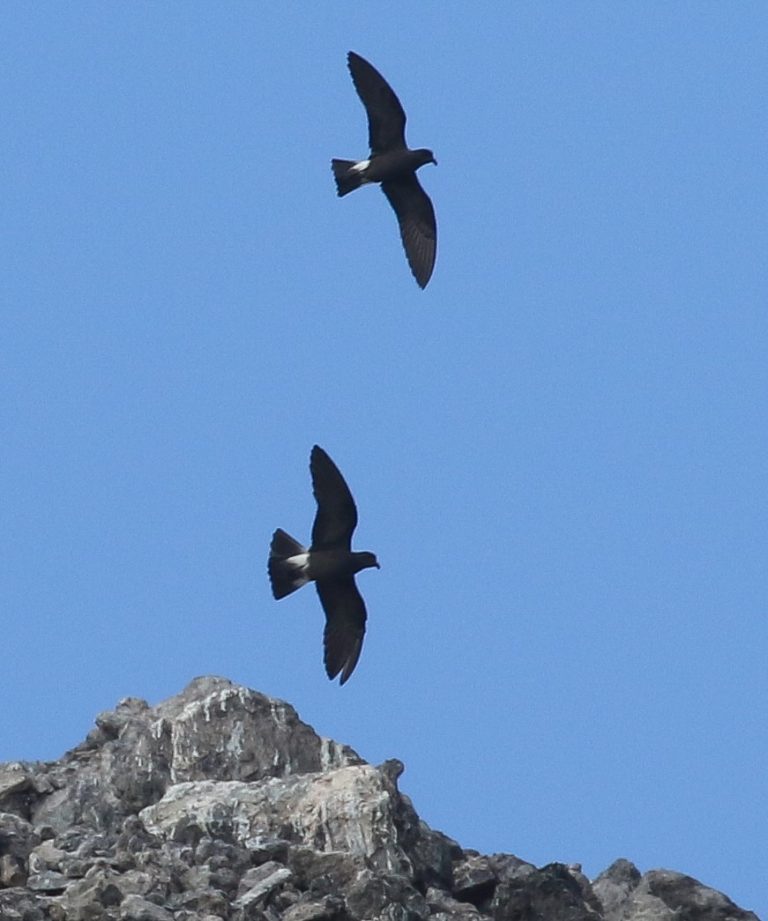
“St. Helena Storm-Petrel”, H. c. helena, ventral view showing white extending far down the sides of the undertail—more evident on the lower bird. (Speery Island, St. Helena; April 18, 2018.) © studland birder

“St. Helena Storm-Petrel”, H. c. helena, ventral view showing white extending only partway down the sides of the undertail. (Speery Island, St. Helena; April 18, 2018.) © studland birder
As with most dark storm-petrels, all band-rumped-types typically show a paler brown or whitish diagonal stripe on the wing coverts, but the boldness varies depending on molt-stage and lighting. So the apparent color and boldness of the wingbar can provide clues to the age and molt-stage of closely observed individuals.
Juveniles and freshly molted adults have the most pronounced wingbars. On juveniles the bar appears silvery. On fresh adults, the bar is blond. With feather-wear, the bar diminishes and may disappear entirely by the time the next molt begins.

“St. Helena Storm-Petrel”, H. c. helena, showing a deeply notched tail and fresh-looking pale wingbars. (Egg Island, St. Helena; November 30, 2014.) © Dave Higgins
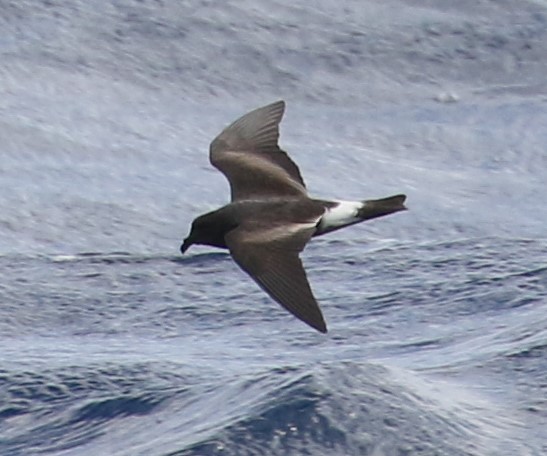
“St. Helena Storm-Petrel”, H. c. helena, showing a shallowly notched tail, thick bill, and fresh-looking pale wingbars. (Offshore from St. Helena; April 18, 2018.) © studland birder
Voice. There appear to be no publicly available recordings. In general, band-rumped-type storm-petrels give two main call-types at breeding colonies, chattering and purring, but they differ in their patterns.
Studies of the vocalizations of North Atlantic band-rumpeds have been instrumental to understanding the relationships among similar-looking forms. Such studies in the South Atlantic will likely be needed to understand the taxonomic status of each breeding population.
Notes
Monotypic form, one of seven or more potentially distinct forms of Band-rumped Storm-Petrel (castro), which is in the midst of taxonomic revisions. Eventually, it seems likely that the South Atlantic forms will be classified as one or more species separate from the North Atlantic and Pacific forms.
A genetic analysis published in 2019 (Taylor et al.) concluded that all of the Pacific forms were closely related to one another, and also to the “St. Helena” form in the South Atlantic. The close affiliation of the Pacific populations is not surprising, but their apparent affiliation with a single Atlantic population presents an unexpected complication.
See below for a comparison of the “St. Helena Storm-Petrel” with other Atlantic members of the Band-rumped Storm-Petrel complex.
Cf. Other Atlantic Band-rumped-type storm-petrels. At least six cryptic species or forms in the Band-rumped Storm-Petrel complex have been recognized in the Atlantic. Four breed on North Atlantic archipelagos of Macaronesia and two on widely scattered islands of the South Atlantic. Apart from their breeding grounds, the ranges of these forms remain mostly unknown. Sightings are scarce and the forms are extremely difficult to distinguish from one another at sea.
The four North Atlantic forms overlap with one another to varying degrees and are known to differ vocally. In brief, all four have two similar call types—chattering and purring—which vary in length, pattern, and complexity. Differing calls have helped to confirm their respective breeding distributions, but they generally call only on the breeding grounds and only at night.
In most cases, under most conditions, the visual differences among the forms are too subtle and inconsistent for field identification. With that caveat, following is a summary of factors that might help in exceptional circumstances—the forms are listed by the average latitudes of their breeding grounds, from north to south.

Cape Verde Storm-Petrel—identification presumed based on the location, far out at sea south of Cape Verde, though any of the Atlantic band-rumped forms could occur there at any time of year. (May 4, 2011.) © Graham Ekins
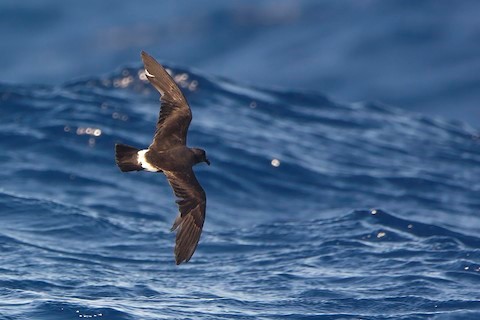
“Madeiran Storm-Petrel”, H. c. castro —likely this subspecies, based on molt-stage, season, and location within its known breeding range—but these factors are also consistent with Monteiro’s, Cape Verde, and first-year “Grant’s”, all plausible alternative identifications. (Offshore northeast of Lanzarote, Canary Islands, Spain; November 1, 2014.) © Miguel Rouco
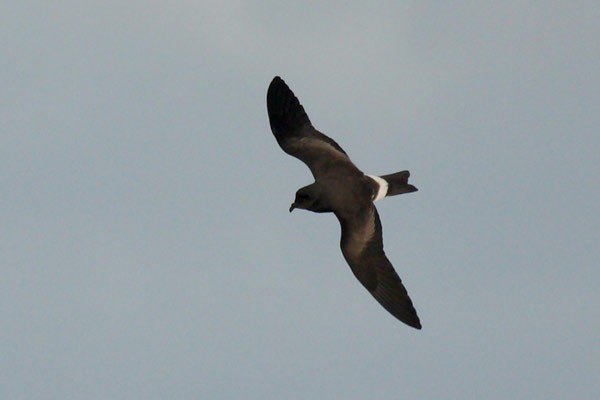
Monteiro’s Storm-Petrel—based on large samples of measured individuals at their Azorean breeding sites, Monteiro’s tends to have a more deeply notched tail than “Grant’s”, but their measurements overlap. (Offshore from Graciosa, Açores, Portugal; May 2011.) © Gareth Knass

“Gulf of Guinea Storm-Petrel”, H. c. ssp. nova, showing apparently thin rump-band and long-looking tail. © William H. Wagstaff
Monteiro’s Storm-Petrel (monteroi): Breeds in the Azores from March to October (eggs laid from early May to early July). Gives the shortest, simplest calls, with a rougher, scratchier quality than the others. Relatively small-bodied, long-tailed, and long-winged, and usually has a visibly notched tail.
“Grant’s Storm-Petrel” (ssp. nova): Breeds from the Azores east to the Berlengas and south to the Canaries from August to April (eggs laid from early October to early December). Calls end with signature punctuation. Relatively large and robust, and has a squarish or shallowly notched tail. Post-breeding adults show heavy feather-wear and/or molting flight feathers most noticeably from April to June—when Monteiro’s and “Madeiran” are fresh-plumaged.
“Madeiran Storm-Petrel” (castro): Breeds in Madeira, the Selvagens, and the Canaries from April to October (eggs laid in June and July). Calls are squeaky, rapid, about intermediate in length between Monteiro’s and Cape Verde, and lack the particular ending of “Grant’s”. Relatively small and slim overall; tail can appear either square-tipped or notched.
Cape Verde Storm-Petrel (jabejabe): Breeds in Cape Verde over an extended season, possibly year-round with two peaks—one from October into winter, the other from April into summer. Gives the longest, most complex calls, and genetic analyses indicate that it is the oldest divergent lineage in the band-rumped complex. Proportions are average, and has a squarish or shallowly notched tail.
“Gulf of Guinea Storm-Petrel” (ssp. nova): Breeds on São Tomé over an extended season, possibly year-round. Calls are relatively long and complex, suggesting an affinity with Cape Verde. Appears slightly larger than other forms, with a narrow white rump band and long-looking squarish or shallowly notched tail.
“St. Helena Storm-Petrel” (helena): Breeds on St. Helena and Ascension in two seasons—possibly multiple distinct forms or cryptic species—one from October to March, the other from April to September. Attends the nest diurnally. On some individuals the white rump band extends far down undertail coverts. Slightly larger than most other forms; usually shows a visibly notched tail.
Additional Photos of “St. Helena Storm-Petrel”
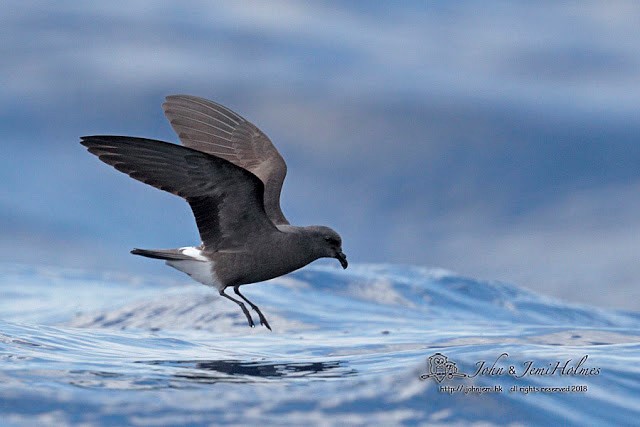
“St. Helena Storm-Petrel”, H. c. helena, ventral view showing white extending far down the sides of the undertail. (Offshore from St. Helena; April 18, 2018.) © John & Jemi Holmes
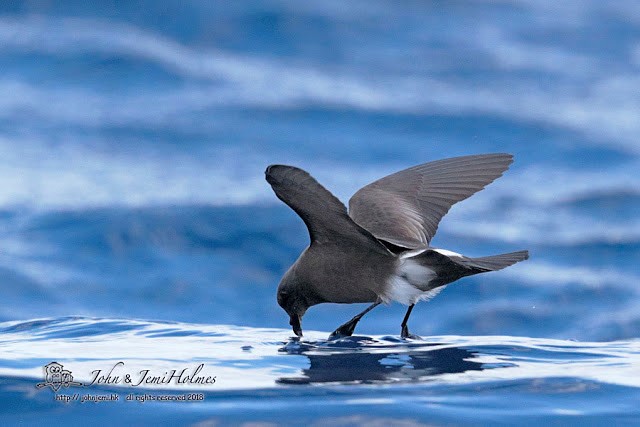
“St. Helena Storm-Petrel”, H. c. helena, ventral view showing white extending far down the sides of the undertail. (Offshore from St. Helena; April 18, 2018.) © John & Jemi Holmes
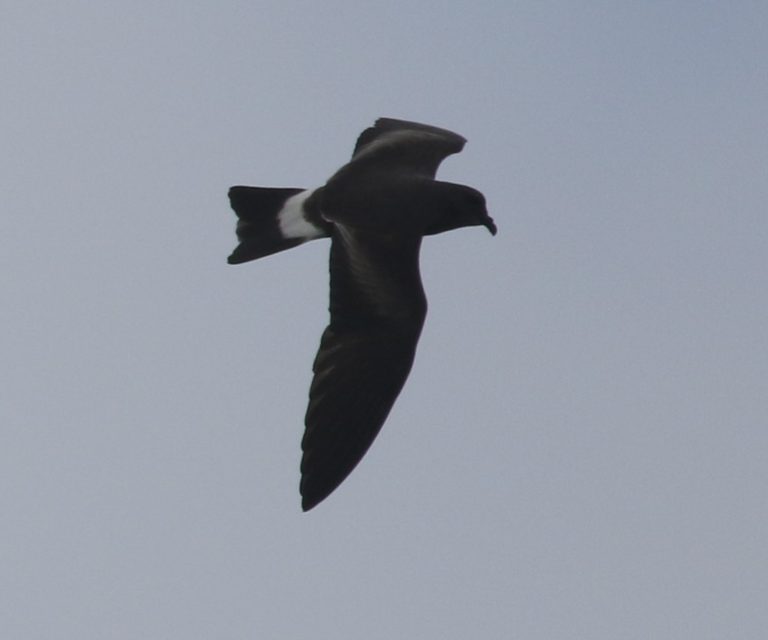
“St. Helena Storm-Petrel”, H. c. helena, showing a shallowly notched tail. (Speery Island, St. Helena; April 18, 2018.) © studland birder
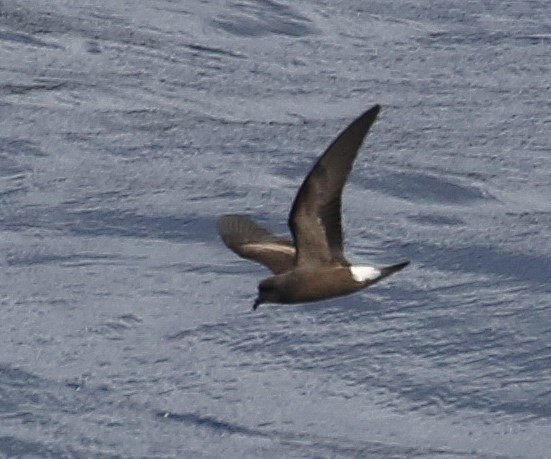
“St. Helena Storm-Petrel”, H. c. helena, ventral view showing white extending only partway down the sides of the undertail. (Offshore from Ascension Island; April 24, 2018.) © studland birder
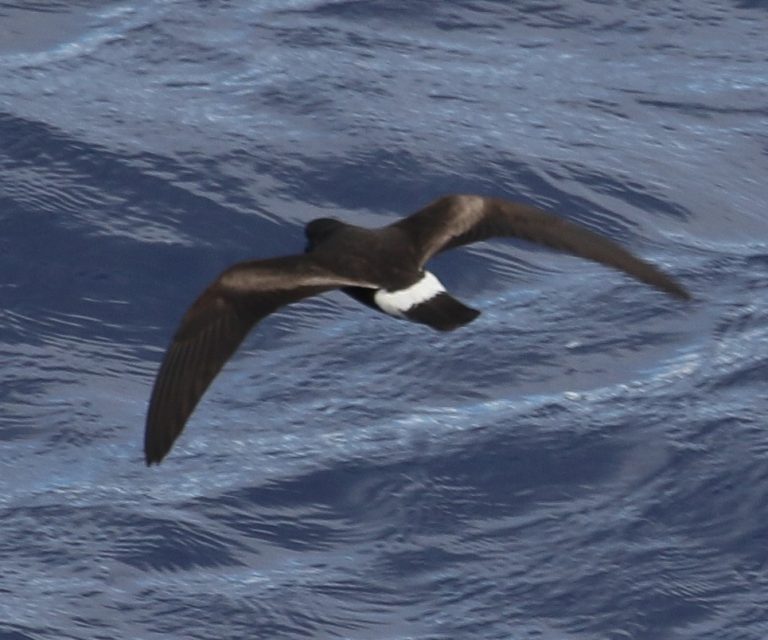
“St. Helena Storm-Petrel”, H. c. helena, showing an apparently square-tipped tail. (Offshore from Ascension Island; April 24, 2018.) © studland birder
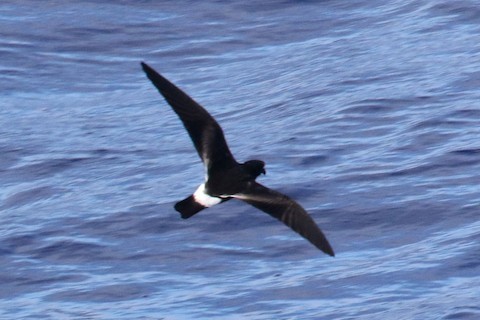
“St. Helena Storm-Petrel”, H. c. helena, showing a shallowly notched tail and silvery wingbars. (Offshore south of St. Helena; March 30, 2018.) © Noah Strycker
References
BirdLife International. 2018. Hydrobates castro. The IUCN Red List of Threatened Species 2018: e.T132341128A132433305. https://dx.doi.org/10.2305/IUCN.UK.2018-2.RLTS.T132341128A132433305.en. (Accessed December 26, 2021.)
eBird. 2021. eBird: An online database of bird distribution and abundance. Cornell Lab of Ornithology, Ithaca, N.Y. http://www.ebird.org. (Accessed December 26, 2021.)
Harrison, P. 1983. Seabirds: An Identification Guide. Houghton Mifflin, Boston.
Howell, S.N.G., and K. Zufelt. 2019. Oceanic Birds of the World. Princeton University Press.
Onley, D., and P. Scofield. 2007. Albatrosses, Petrels & Shearwaters of the World. Princeton University Press.
Taylor, R.S., M. Bolton, A. Beard, T. Birt, P. Deane-Coe, A.F. Raine, J. González-Solís, S.C. Lougheed, and V.L. Friesen. 2019. Cryptic species and independent origins of allochronic populations within a seabird species complex (Hydrobates spp.). Molecular Phylogenetics and Evolution 139:106552.
Xeno-Canto. 2021. Band-rumped Storm Petrel – Oceanodroma castro. https://xeno-canto.org/species/Oceanodroma-castro. (Accessed December 26, 2021.)
